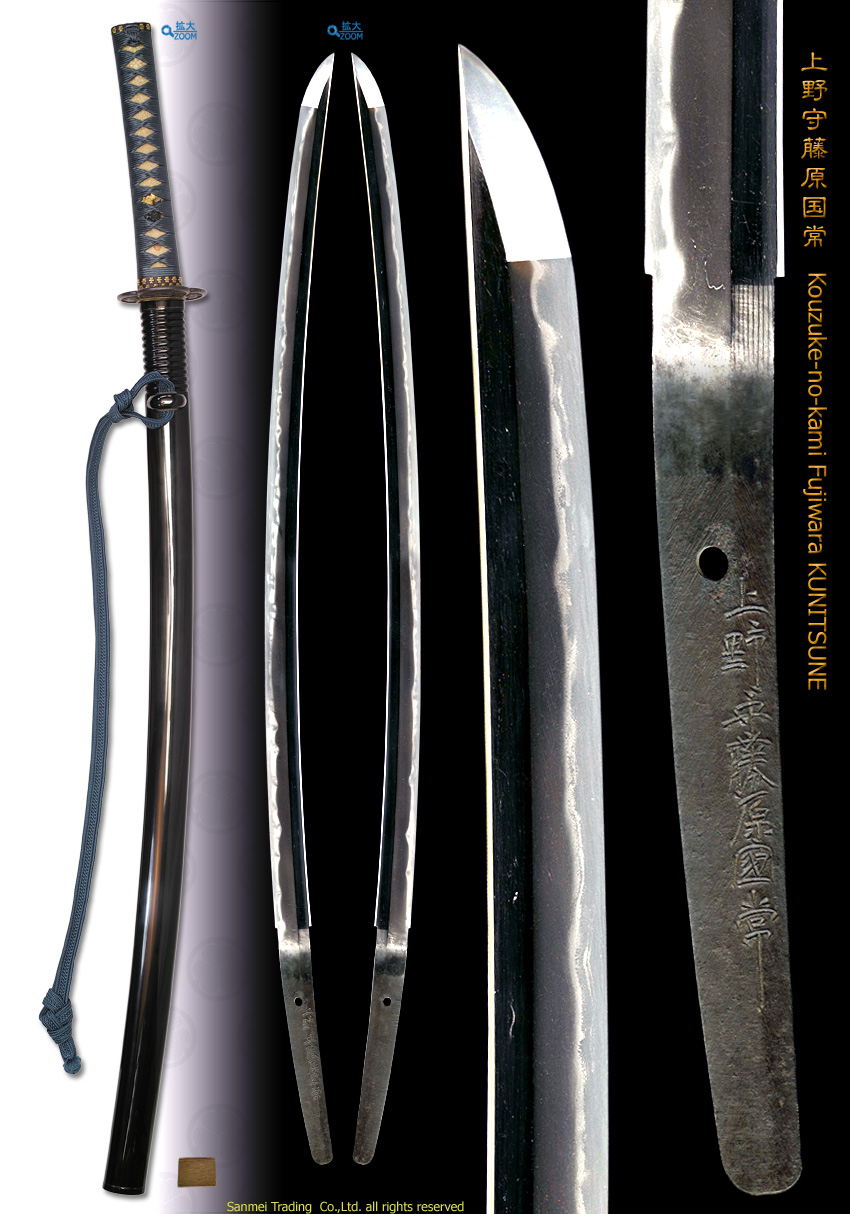with) Black lacquered waist 2-bu notches Uchikatana Koshirae
NBTHK(Hozon Tousougu) for Tsuba
Length of cutting edge 71.3cm Curvature 1.9cm Width of base 29.5mm Width of Yokote 21.5mm Thickness of base 6.5mm
Forging(Hada): Forging is fine Itame on Hiraji whereas Shinogi-ji shows conspicuous Masame. Thick sparkling hard metal granules Ji-nie appears on Hira-ji surface. Darkish Itame pattern of Nie activity so called Chikei wells out from fine steel.
Temper(Hamon): Hamon is based on a bit coarse side Nie hard metal granules undulating Gunome, Togari-ha, Box-shape or Notch-arrow shape Yahazu-ha. Some splitting Tobiyaki or isolated Yubashiri and Niju-ha appears here and there. The interior of temper is filled with mist-like crystallize area deeply with abundant activities of Nie such as short lines of Nie-Sunagashi and long bright curved thread-like Kinsen areas. The entire temper gives off extremely vivid and bright impression.
Temper of tip(Boshi): Boshi forms like a surge of flame.
Tang(Nakago): Nakago is in UBU original with slight curve in Nakago itself and Double bevelled (Kurijiri) heel. One Mekugi-ana peg hole. V-shaped (Taka-no-ha) filemarks and the back ridge of Nakago is flat with Horizontal (Kiri) filemarks. The signature in front is located along Shinogi-suji that starts from the official district title of Kouzuke-no-kami 上野守, name of clan Fujiwara 藤原 and the smith name KUNITSUNE 国常 in which specimen of the last stroke TSUNE 常 is chiselled exceedingly long.
End of Muromachi period, an age of turbulence Warning State period in the central districts of Mino, Owari and Mikawa, while Oda Nobunaga 織田信長 was strikingly on the rise. Mino sword makers had successfully met with increasing demand from sudden rise to power of Samurai's.
Kouzuke-no-kami Fujiwara KUNITSUNE 上野守藤原国常 is reportedly a second son of the first smith Sagami-no-kami MASATSUNE 相模守政常, born in Nodo-town, Mino province (now Sen-nen town, Seki-city, Gifu-pref.) The given name is Sakunoshin 作之進, descendant of Nara-Taro KANETSUNE 奈良太郎兼常.
He initially lived in Gifu and moved to Kiyosu castle town then lived in Tomita-town, Nagoya (now in Sakura-dori Honmachi, Naka-ku, Nagoya) when Nagoya castle relocation in the 2nd month, the 15th year of Keicho(1610) accompanying his father master Sagami-no-kami MASATSUNE 相模守政常.
Because of his legitimate elder brother 2nd MASATSUNE died young, he reportedly supported his elder brother in law Mino-no-kami MASATSUNE 美濃守政常 as well as aged father Sagami-no-kami MASATSUNE Nyudo 相模守政常入道 in his later age.
This katana is created in well-harmonized construction so called Kan'ei shinto style during the transition from Keicho era. Both Iori-mune and Shinogi-suji are impressively high holding durable construction that leads to elongated powerful Kissaki. Strong Nie-based Yamato workmanship is clearly perceived with abundant Nie activity based on Mino tradition of Hamon as well as the typical V-shaped filemark of Nakago.
with) Black lacquered waist 2-bu notches Uchikatana Koshirae (click HERE for entire Koshirae / HERE for each fitting)
- Fuchi/kashira : KIRI crest design, Shakudo ground Nanako-ji surface, Takabori, gold Iroe, unsigned
- Menuki : Nihiki-Shishi LEO design, Shakudo ground, Yobori carving, Gold Iroe
- Tsuba : Wachigai Kiri crest openwork design, Iron ground, Nikubori carving, unsigned attributed to a work of Shoami (NBTHK Hozon)
- Tsuka : White laysklin, Nando (gray indigo-blue) silk cord Kata-Hineri-maki style lozenge wrap
Excellent polish/Condition scale: excellent (using a scale of mint-excellent-very good-good-fair-poor).
reference data : Iwata Atou, Owari Toukoufu, Nagoya board of education,1984



